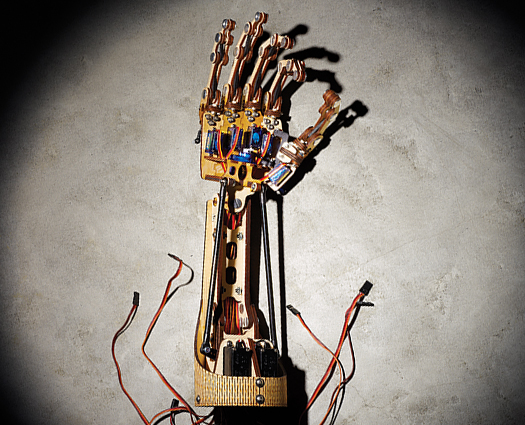

Brian Roe spent nearly a decade building animatronic monsters for films such as Virus, A.I., and Scooby Doo 2. Then, almost overnight, Hollywood abandoned mechanical characters for computer renderings. Roe now works as a technology consultant, but with the surge of cheap, user-friendly microelectronics, he saw a market emerging for hobbyist robots. “It used to be that electronics and software were out of reach,” Roe says. “Over the past six or eight years, it has completely switched.” So Roe began developing a low-cost kit to teach anyone robotics. He calls his work-in-progress Roy the Robot.
For now, Roy is a head, neck, and pair of lower arms. Yet, with about 1,200 parts controlled by animatronics software, the robot already looks and moves like a human. Roe laser-cut the robot’s frame from pliable, lightweight wood to retain complex architecture while keeping costs low. Twenty-eight inexpensive servomotors help Roy gesture with his hands; move his wrist, neck, and jaw; and even blink his eyes.
To complete Roy’s upper arms and shoulders, Roe launched a successful crowdfunding campaign and sent backers DIY kits based on the hands and arms. He eventually hopes to sell the kits for about $300. That would fill a need for inexpensive manipulators. “The cheapest capable robotic arms are in the $20,000 range,” says Siddhartha Srinivasa, a roboticist at Carnegie Mellon University.
Roe estimates that a full robot kit with a torso and legs might cost $3,000, and he hopes to one day imbue Roy with enough artificial intelligence to learn human motion. “But my main goal is to help people build, program, and understand robotics,” Roe says. “Because, in the end, we’re going to live in a robotic society.”

INVENTOR
Brian Roe
COMPANY
Roemotion
INVENTION
Roy the Robot
COST TO DEVELOP
$9,000
MATURITY
4/10
See the rest of the articles from our 2013 Invention Awards section here, and see all of our May issue here.
